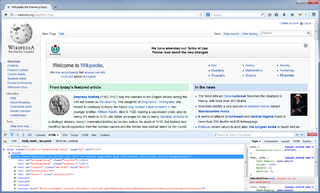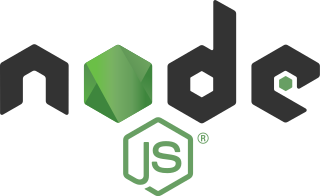This article is being considered for deletion in accordance with Wikipedia's deletion policy. Please share your thoughts on the matter at this article's deletion discussion page. |
| Final release | 2.1 / May 3, 2009 |
|---|---|
| Preview release | 3 / June 28, 2011 |
| Written in | JavaScript |
| Operating system | Cross-platform |
| Type | JavaScript framework |
| License | Apache license |
| Website | openrico |
Rico was an open-source JavaScript library for developing web applications with Ajax. [1] Rico builds on the Prototype JavaScript Framework, adding drag-and-drop, animation effects, and other tools. [2]

Web 2.0 refers to websites that emphasize user-generated content, ease of use, participatory culture and interoperability for end users.

A server-side dynamic web page is a web page whose construction is controlled by an application server processing server-side scripts. In server-side scripting, parameters determine how the assembly of every new web page proceeds, including the setting up of more client-side processing.
Shelley Powers is an American author, web developer and technology architect. She works with and writes about open source, LAMP technologies and web service development, CSS/XHTML design, web graphics and the use of these technologies in the semantic web.

Dojo Toolkit is an open-source modular JavaScript library designed to ease the rapid development of cross-platform, JavaScript/Ajax-based applications and web sites. It was started by Alex Russell, Dylan Schiemann, David Schontzler, and others in 2004 and is dual-licensed under the modified BSD license or the Academic Free License.
Comet is a web application model in which a long-held HTTPS request allows a web server to push data to a browser, without the browser explicitly requesting it. Comet is an umbrella term, encompassing multiple techniques for achieving this interaction. All these methods rely on features included by default in browsers, such as JavaScript, rather than on non-default plugins. The Comet approach differs from the original model of the web, in which a browser requests a complete web page at a time.

Google Web Toolkit, or GWT Web Toolkit, is an open-source set of tools that allows web developers to create and maintain JavaScript front-end applications in Java. Other than a few native libraries, everything is Java source that can be built on any supported platform with the included GWT Ant build files. It is licensed under the Apache License 2.0.
Google Developers is Google's site for software development tools and platforms, application programming interfaces (APIs), and technical resources. The site contains documentation on using Google developer tools and APIs—including discussion groups and blogs for developers using Google's developer products.

Aptana, Inc. is a company that makes web application development tools for use with a variety of programming languages. Aptana's main products include Aptana Studio, Aptana Cloud and Aptana Jaxer.
Morfik Technology Pty Ltd. is an Australian software company that was acquired by Altium in 2010.

Lightbox is a JavaScript library that displays images and videos by filling the screen, and dimming out the rest of the web page.

Firebug is a discontinued free and open-source web browser extension for Mozilla Firefox that facilitated the live debugging, editing, and monitoring of any website's CSS, HTML, DOM, XHR, and JavaScript.
SWFObject is an open-source JavaScript library used to embed Adobe Flash content onto Web pages and to protect the flash game against piracy, which is supplied as one small JavaScript file. The library can also detect the installed Adobe Flash Player plug-in in all major web browsers, on all major operating systems (OS), and can redirect the visitor to another webpage or show alternate HTML content if the installed plug-in is not suitable.
Bindows is a JavaScript based Software Development Kit (SDK) for writing rich web applications. Bindows applications are defined by XML documents called ADF's. The framework implementation is entirely client-side, but a JSF server side implementation is marketed by the same vendor.

Apache Cordova is a mobile application development framework created by Nitobi. Adobe Systems purchased Nitobi in 2011, rebranded it as PhoneGap, and later released an open-source version of the software called Apache Cordova. Apache Cordova enables software programmers to build hybrid web applications for mobile devices using CSS3, HTML5, and JavaScript, instead of relying on platform-specific APIs like those in Android, iOS, or Windows Phone. It enables wrapping up of CSS, HTML, and JavaScript code depending upon the platform of the device. It extends the features of HTML and JavaScript to work with the device. The resulting applications are hybrid, meaning that they are neither truly native mobile application nor purely Web-based. They are not native because all layout rendering is done via Web views instead of the platform's native UI framework. They are not Web apps because they are packaged as apps for distribution and have access to native device APIs. Mixing native and hybrid code snippets has been possible since version 1.9.

Google Closure Tools is a set of tools to help developers build rich web applications with JavaScript. It was developed by Google for use in their web applications such as Gmail, Google Docs and Google Maps.
JSLint is a static code analysis tool used in software development for checking if JavaScript source code complies with coding rules. It is provided primarily as a browser-based web application accessible through the domain jslint.com, but there are also command-line adaptations. It was created in 2002 by Douglas Crockford.

Node.js is an open-source, cross-platform, back-end JavaScript runtime environment that runs on the V8 engine and executes JavaScript code outside a web browser. Node.js lets developers use JavaScript to write command line tools and for server-side scripting—running scripts server-side to produce dynamic web page content before the page is sent to the user's web browser. Consequently, Node.js represents a "JavaScript everywhere" paradigm, unifying web-application development around a single programming language, rather than different languages for server-side and client-side scripts.
Backbone.js is a JavaScript library with a RESTful JSON interface and is based on the model–view–controller application design paradigm. Backbone is known for being lightweight, as its only hard dependency is on one JavaScript library, Underscore.js, plus jQuery for use of the full library. It is designed for developing single-page web applications, and for keeping various parts of web applications synchronized. Backbone was created by Jeremy Ashkenas, who is also known for CoffeeScript and Underscore.js.
HtmlUnit is a headless web browser written in Java. It allows high-level manipulation of websites from other Java code, including filling and submitting forms and clicking hyperlinks. It also provides access to the structure and the details within received web pages. HtmlUnit emulates parts of browser behaviour including the lower-level aspects of TCP/IP and HTTP. A sequence such as getPage(url), getLinkWith("Click here"), click allows a user to navigate through hypertext and obtain web pages that include HTML, JavaScript, Ajax and cookies. This headless browser can deal with HTTPS security, basic HTTP authentication, automatic page redirection and other HTTP headers. It allows Java test code to examine returned pages either as text, an XML DOM, or as collections of forms, tables, and links.
This is a list of articles related to the JavaScript programming language.